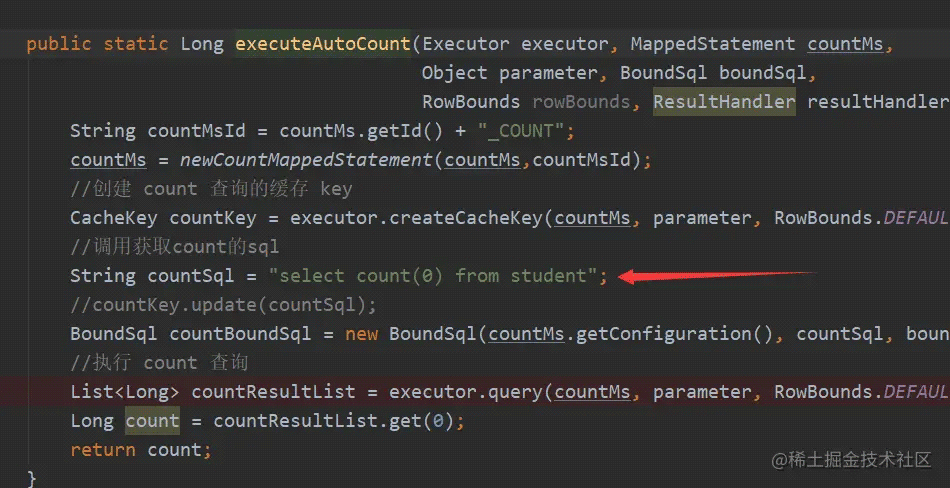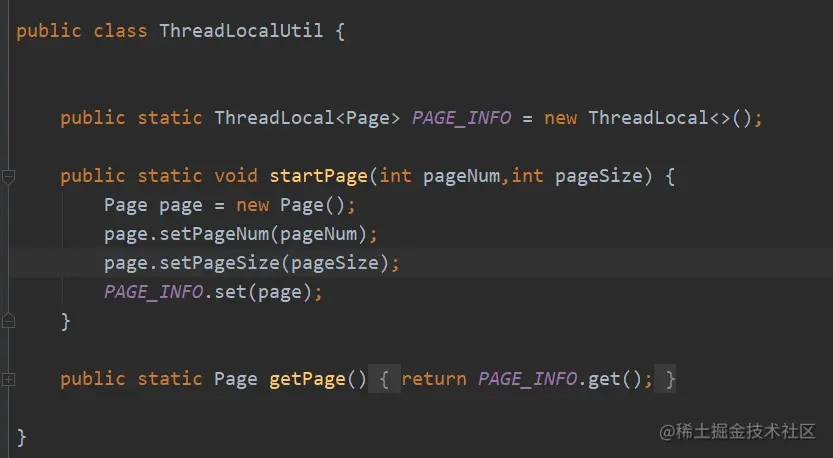Mybatis分页插件PageHelper手写实现示例
目录
- 引言
- 编写我们的插件类
- 上面有二个核心方法
- 获取记录总数
- 分页查询记录数
- 如何获取前端传递过来的参数?
- 总结
引言
PageHelper是一个非常好用的插件,以至于很想知道它底层是怎么实现的。至于MyBatis插件概念原理网上有很多,我不太喜欢去写一些概念性的东西,我比较喜欢自己动手实现的那种,话不多说,我们开干
搭建一个SpringBoot+MyBatis+MySql项目
编写我们的插件类
package com.example.demo.plugin;
import org.apache.ibatis.cache.CacheKey;
import org.apache.ibatis.executor.Executor;
import org.apache.ibatis.mapping.BoundSql;
import org.apache.ibatis.mapping.MappedStatement;
import org.apache.ibatis.plugin.*;
import org.apache.ibatis.session.ResultHandler;
import org.apache.ibatis.session.RowBounds;
import java.util.HashMap;
import java.util.List;
import java.util.Map;
import java.util.Properties;
@Intercepts(
{
@Signature(type = Executor.class,
method = "query",
args = {MappedStatement.class, Object.class, RowBounds.class, ResultHandler.class}),
@Signature(type = Executor.class,
method = "query",
args = {MappedStatement.class, Object.class, RowBounds.class, ResultHandler.class,
CacheKey.class, BoundSql.class}),
}
)
public class MyPagePlugin implements Interceptor {
@Override
public Object intercept(Invocation invocation) throws Throwable {
Object[] args = invocation.getArgs();
MappedStatement ms = (MappedStatement) args[0];
Object parameter = args[1];
RowBounds rowBounds = (RowBounds) args[2];
ResultHandler resultHandler = (ResultHandler) args[3];
Executor executor = (Executor) invocation.getTarget();
CacheKey cacheKey;
BoundSql boundSql;
//由于逻辑关系,只会进入一次
if (args.length == 4) {
//4 个参数时
boundSql = ms.getBoundSql(parameter);
cacheKey = executor.createCacheKey(ms, parameter, rowBounds, boundSql);
} else {
//6 个参数时
cacheKey = (CacheKey) args[4];
boundSql = (BoundSql) args[5];
}
== 其实在这之上的代码都是拷贝PageHelper源码来的,下面才是重头戏,上面都是获取一些必要的参数==
/**
* 下面4行代码暂时只需要知道是用来传参数的就行,分页不是需要
* 二个参数嘛 一个是当前页,一个是数量
*/
Page page = ThreadLocalUtil.getPage();
Map<String,Object> params = new HashMap<>();
params.put("first_key",page.getPageNum());
params.put("second_key",page.getPageSize());
/**
* 重点:获取数据库记录总数
*/
//统计总数
Long count = MyExecutorUtil.executeAutoCount(executor,ms,parameter,boundSql,rowBounds,resultHandler);
/**
* 重点:分页查询
*/
List<Object> objects = MyExecutorUtil.pageQuery(executor, ms, parameter, rowBounds, resultHandler, boundSql, cacheKey, params);
return objects;
}
@Override
public Object plugin(Object target) {
return Plugin.wrap(target, this);
}
@Override
public void setProperties(Properties properties) {
}
}
上面有二个核心方法
1:获取记录总数:
MyExecutorUtil.executeAutoCount(executor,ms,parameter,boundSql,rowBounds,resultHandler);
2:分页查询:
MyExecutorUtil.pageQuery(executor, ms, parameter, rowBounds, resultHandler, boundSql, cacheKey,params);
获取记录总数
1:MyBatis源码底层会封装好我们在配置文件中写的每一条SQL语句,封装到一个SqlSource对象中去,在我们执行SQL的时候,会获取到这条SQL,然后封装到BoundSql这个对象中,所以在这里,我们既然能拿到BoundSql,那么也就意味着我们能拿到我们需要执行的那条Sql了

2:获取到了我们的sql之后,怎么查询总记录数呢??
其实很简单,改Sql语句不就好了,Pagehelper底层也是这么做的,但是PageHelper底层比我这个版本的复杂太多了,但是我们无非就是将原先的SQL转换成 -> SELECT COUNT(0) FROM TABLE,就这样,但是我这个人比较懒,而且昨天看这个源码实现头疼,所以在这里直接写死了,但是问题不大哈

3:改好了Sql之后是不是就完成了呢??
当然不是,改好了SQL当然是要去执行它了,如果就这样执行,还是会执行原先的SQL,但是你要知道这个有个很关键的东西,就是MappedStatement的id,如果不改这个id的话,即使你的Sql能够执行成功,那么返回的记录总数是个NULL,这里我想可能是因为ResultSetHandle的关系,因为这个id对应的还是我们之前的sql,也就是select * from student,那么必然有一个resultType的属性,也就是实体类映射,但是我们现在的sql是select count(0) from student,那么就对应不上了,也就是数据库查询出来的列与实体类对应不上,所以我们需要改变这个id。

//改变MapperStatement id的方法
public static MappedStatement newCountMappedStatement(MappedStatement ms, String newMsId) {
MappedStatement.Builder builder = new MappedStatement.Builder(ms.getConfiguration(), newMsId, ms.getSqlSource(), ms.getSqlCommandType());
builder.resource(ms.getResource());
builder.fetchSize(ms.getFetchSize());
builder.statementType(ms.getStatementType());
builder.keyGenerator(ms.getKeyGenerator());
if (ms.getKeyProperties() != null && ms.getKeyProperties().length != 0) {
StringBuilder keyProperties = new StringBuilder();
for (String keyProperty : ms.getKeyProperties()) {
keyProperties.append(keyProperty).append(",");
}
keyProperties.delete(keyProperties.length() - 1, keyProperties.length());
builder.keyProperty(keyProperties.toString());
}
builder.timeout(ms.getTimeout());
builder.parameterMap(ms.getParameterMap());
//count查询返回值int
List<ResultMap> resultMaps = new ArrayList<ResultMap>();
ResultMap resultMap = new ResultMap.Builder(ms.getConfiguration(), ms.getId(), Long.class, EMPTY_RESULTMAPPING).build();
resultMaps.add(resultMap);
builder.resultMaps(resultMaps);
builder.resultSetType(ms.getResultSetType());
builder.cache(ms.getCache());
builder.flushCacheRequired(ms.isFlushCacheRequired());
builder.useCache(ms.isUseCache());
return builder.build();
}
4:MyBatis的Sql是封装到BoundSql中去的,而原先的BoundSql中的Sql是我们配置文件中的,所以我们需要将select count(0) from student这条Sql语句封装到一个新的BoundSql中去
public static Long executeAutoCount(Executor executor, MappedStatement countMs,
Object parameter, BoundSql boundSql,
RowBounds rowBounds, ResultHandler resultHandler) throws SQLException {
//改变MapperStatement中的ID属性
String countMsId = countMs.getId() + "_COUNT";
countMs = newCountMappedStatement(countMs,countMsId);
//创建 count 查询的缓存 key
CacheKey countKey = executor.createCacheKey(countMs, parameter, RowBounds.DEFAULT, boundSql);
//调用获取count的sql
String countSql = "select count(0) from student";
//重新封装BoundSql对象
BoundSql countBoundSql = new BoundSql(countMs.getConfiguration(), countSql, boundSql.getParameterMappings(), parameter);
//执行 count 查询
List<Long> countResultList = executor.query(countMs, parameter, RowBounds.DEFAULT, resultHandler, countKey, countBoundSql);
Long count = countResultList.get(0);
return count;
}
5:最后调用executor.query方法就可以得到我们的记录总数了
分页查询记录数
- 1:其实分页查询与查询记录总数的原理是一样的
- 2:首先获取原先的BoundSql中的Sql,也就是我们在配置文件中的Sql,比如 select * from student
- 3:然后获取我们的分页参数,也就是前端传递过来的pageNum和pageSize二个参数
- 4:修改Sql,select * from student limit ?,?
- 5:这次我们就不用修改MapperStatement中的ID了,因为查询出来的都是studnet,所以映射不用修改
- 6:重新实例化一个BoundSql对象,将新的Sql传递给它
- 7:最后执行executor.query方法查询,得到结果
如何获取前端传递过来的参数?
1:我这里使用的是ThreadLocal,



总结
- 1:首选我们需要获取到原先需要执行的sql
- 2:然后修改这条修改,分页查询无非就是总记录数,分页查询的记录数
- 3:分别执行这二条Sql,得到我们想要的结果
源码:
就下面这5个类,其它的就是将SpringBoot+MyBatis+MySql日常配置就行了,然后再Controller记得传递一下参数

package com.example.demo.plugin;
import org.mybatis.spring.annotation.MapperScan;
import org.springframework.context.annotation.Bean;
import org.springframework.context.annotation.Configuration;
@Configuration
@MapperScan({"com.example.demo.mapper"})
public class MapperConfig {
@Bean
public MyPagePlugin myPagePlugin() {
return new MyPagePlugin();
}
}
package com.example.demo.plugin;
import com.example.demo.entity.Student;
import org.apache.ibatis.cache.CacheKey;
import org.apache.ibatis.executor.Executor;
import org.apache.ibatis.mapping.*;
import org.apache.ibatis.session.Configuration;
import org.apache.ibatis.session.ResultHandler;
import org.apache.ibatis.session.RowBounds;
import java.sql.SQLException;
import java.util.ArrayList;
import java.util.List;
import java.util.Map;
public class MyExecutorUtil {
private static final List<ResultMapping> EMPTY_RESULTMAPPING = new ArrayList<ResultMapping>(0);
public static <E> List<E> pageQuery(Executor executor, MappedStatement ms, Object parameter,
RowBounds rowBounds, ResultHandler resultHandler,
BoundSql boundSql, CacheKey cacheKey,Map<String,Object> params) throws SQLException {
executor.clearLocalCache();
//生成分页的缓存 key
CacheKey pageKey = cacheKey;
//处理参数对象
if(params.size() < 0 || params.size() > 2) {
System.out.println("参数错误");
}
//获取sql
String pageSql = getPageSql(params.size(),boundSql);
List<ParameterMapping> mappingList = new ArrayList<>();
mappingList.add(new ParameterMapping.Builder(ms.getConfiguration(), "first_key", Integer.class).build());
mappingList.add(new ParameterMapping.Builder(ms.getConfiguration(), "second_key", Integer.class).build());
//实例化新的BoundSql对象
BoundSql pageBoundSql = new BoundSql(ms.getConfiguration(), pageSql, mappingList, params);
//执行分页查询
return executor.query(ms, params, RowBounds.DEFAULT, resultHandler, pageKey, pageBoundSql);
}
public static Long executeAutoCount(Executor executor, MappedStatement countMs,
Object parameter, BoundSql boundSql,
RowBounds rowBounds, ResultHandler resultHandler) throws SQLException {
//改变MapperStatement中的ID属性
String countMsId = countMs.getId() + "_COUNT";
countMs = newCountMappedStatement(countMs,countMsId);
//创建 count 查询的缓存 key
CacheKey countKey = executor.createCacheKey(countMs, parameter, RowBounds.DEFAULT, boundSql);
//调用获取count的sql
String countSql = "select count(0) from student";
//重新封装BoundSql对象
BoundSql countBoundSql = new BoundSql(countMs.getConfiguration(), countSql, boundSql.getParameterMappings(), parameter);
//执行 count 查询
List<Long> countResultList = executor.query(countMs, parameter, RowBounds.DEFAULT, resultHandler, countKey, countBoundSql);
Long count = countResultList.get(0);
return count;
}
public static MappedStatement newCountMappedStatement(MappedStatement ms, String newMsId) {
MappedStatement.Builder builder = new MappedStatement.Builder(ms.getConfiguration(), newMsId, ms.getSqlSource(), ms.getSqlCommandType());
builder.resource(ms.getResource());
builder.fetchSize(ms.getFetchSize());
builder.statementType(ms.getStatementType());
builder.keyGenerator(ms.getKeyGenerator());
if (ms.getKeyProperties() != null && ms.getKeyProperties().length != 0) {
StringBuilder keyProperties = new StringBuilder();
for (String keyProperty : ms.getKeyProperties()) {
keyProperties.append(keyProperty).append(",");
}
keyProperties.delete(keyProperties.length() - 1, keyProperties.length());
builder.keyProperty(keyProperties.toString());
}
builder.timeout(ms.getTimeout());
builder.parameterMap(ms.getParameterMap());
//count查询返回值int
List<ResultMap> resultMaps = new ArrayList<ResultMap>();
ResultMap resultMap = new ResultMap.Builder(ms.getConfiguration(), ms.getId(), Long.class, EMPTY_RESULTMAPPING).build();
resultMaps.add(resultMap);
builder.resultMaps(resultMaps);
builder.resultSetType(ms.getResultSetType());
builder.cache(ms.getCache());
builder.flushCacheRequired(ms.isFlushCacheRequired());
builder.useCache(ms.isUseCache());
return builder.build();
}
private static String getPageSql(int paramsLength,BoundSql boundSql){
StringBuilder str = new StringBuilder();
str.append(boundSql.getSql());
if(paramsLength == 1) {
str.append(" LIMIT ?");
}else {
str.append(" LIMIT ?,? ");
}
return str.toString();
}
}
package com.example.demo.plugin;
import org.apache.ibatis.cache.CacheKey;
import org.apache.ibatis.executor.Executor;
import org.apache.ibatis.mapping.BoundSql;
import org.apache.ibatis.mapping.MappedStatement;
import org.apache.ibatis.plugin.*;
import org.apache.ibatis.session.ResultHandler;
import org.apache.ibatis.session.RowBounds;
import java.util.HashMap;
import java.util.List;
import java.util.Map;
import java.util.Properties;
@Intercepts(
{
@Signature(type = Executor.class,
method = "query",
args = {MappedStatement.class, Object.class, RowBounds.class, ResultHandler.class}),
@Signature(type = Executor.class,
method = "query",
args = {MappedStatement.class, Object.class, RowBounds.class, ResultHandler.class,
CacheKey.class, BoundSql.class}),
}
)
public class MyPagePlugin implements Interceptor {
@Override
public Object intercept(Invocation invocation) throws Throwable {
Object[] args = invocation.getArgs();
MappedStatement ms = (MappedStatement) args[0];
Object parameter = args[1];
RowBounds rowBounds = (RowBounds) args[2];
ResultHandler resultHandler = (ResultHandler) args[3];
Executor executor = (Executor) invocation.getTarget();
CacheKey cacheKey;
BoundSql boundSql;
//由于逻辑关系,只会进入一次
if (args.length == 4) {
//4 个参数时
boundSql = ms.getBoundSql(parameter);
cacheKey = executor.createCacheKey(ms, parameter, rowBounds, boundSql);
} else {
//6 个参数时
cacheKey = (CacheKey) args[4];
boundSql = (BoundSql) args[5];
}
Page page = ThreadLocalUtil.getPage();
Map<String,Object> params = new HashMap<>();
params.put("first_key",page.getPageNum());
params.put("second_key",page.getPageSize());
//统计总数
Long count = MyExecutorUtil.executeAutoCount(executor,ms,parameter,boundSql,rowBounds,resultHandler);
System.out.println("count = " + count);
List<Object> objects = MyExecutorUtil.pageQuery(executor, ms, parameter, rowBounds, resultHandler, boundSql, cacheKey, params);
return objects;
}
@Override
public Object plugin(Object target) {
return Plugin.wrap(target, this);
}
@Override
public void setProperties(Properties properties) {
}
}
package com.example.demo.plugin;
public class Page {
private Integer pageNum;
private Integer pageSize;
public Integer getPageNum() {
return pageNum;
}
public void setPageNum(Integer pageNum) {
this.pageNum = pageNum;
}
public Integer getPageSize() {
return pageSize;
}
public void setPageSize(Integer pageSize) {
this.pageSize = pageSize;
}
}
package com.example.demo.plugin;
public class ThreadLocalUtil {
public static ThreadLocal<Page> PAGE_INFO = new ThreadLocal<>();
public static void startPage(int pageNum,int pageSize) {
Page page = new Page();
page.setPageNum(pageNum);
page.setPageSize(pageSize);
PAGE_INFO.set(page);
}
public static Page getPage() {
return PAGE_INFO.get();
}
}
@RestController
public class StudnetController {
@Autowired
private StudentMapper studentMapper;
@GetMapping("/getData")
public Object getData() {
ThreadLocalUtil.startPage(0,2);
return studentMapper.getData();
}
}
以上就是Mybatis分页插件PageHelper手写实现示例的详细内容,更多关于Mybatis分页插件PageHelper的资料请关注我们其它相关文章!

